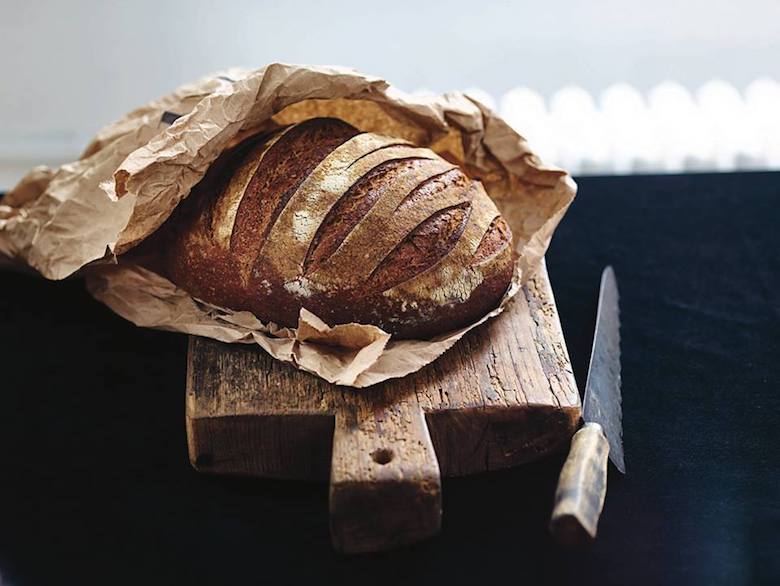Yesterday, we stopped into Bien Cuit in Cobble Hill, where chef Zachary Golper showed us how he makes their buckwheat loaf in the above video. He started out by explaining the reasons he chose this blend of flours, which we’ve transcribed below. Watch the full video to see how he mixes the bread and to hear more of his bread-making tips.
Once one really understands bread-making as an art, then you get into what happens when you blend grains—where you source your grains from and looking for specific flavors. In the same way that a sculptor will have an idea of what they want to make in the sculpture, and they have a raw piece of stone or a rough piece of metal or something they want to form into the image they have in their mind, well, it’s the same thing with the way we at Bien Cuit think about bread. We have an idea of what we want to manifest and then we go through the process of problem-solving to get to that goal—whatever it takes to get to that goal. Sometimes that means fermenting something for six hours and combining that with something that’s fermented for 14 hours. That may be the case. But when those two things marry with the right blend of water, the right different grains that are associated to arriving at that flavor, you end up with what you’re looking for. But it takes a lot of time and it really is, again, it’s an art once you’ve gotten to that level.
To start off, we’ll talk about what that means. When we deal with yeast and we deal with a culture, we’re talking about something that’s invisible. You can’t see yeast; you can’t see bacteria. It’s a micro-organism, but it likes to eat starchy substances and the longer that the enzymes have broken down the starchy substances to allow them to convert from a complex carbohydrate into a simpler carbohydrate, the easier it is for the bacteria and the yeast to consume them.
Now, if you give the yeast and the bacteria a variety of different starchy substances peaking at various different times, they’re going to have the opportunity to eat different things that will give them different gases and acids as the byproduct of their digestion, so you’re going to create an environment of flavor by introducing foods to the yeast and the bacteria. When we talk about those substances, I’ve got here in front of us some of the flours, all four of the flours that we’re going to be using to bake the loaf that we’re making today. The one that you see all the way over on your left side is actually a commodity white flour. This is very, very sifted. This is just the endosperm—the interior of the wheat—and this is sourced from a huge mill all the way on the other side of the Rocky Mountains.
Once one really understands bread-making as an art, then you get into what happens when you blend grains—where you source your grains from and looking for specific flavors.
If I was right there, this would be full of exactly the kind of stuff I’m looking for in a sourdough starter because it would be locally sourced. But the fact is, it comes from the other side of the Rocky Mountains and this is what we’re going to be using as our table flour, our bench flour. It is something that’s very neutral in flavor. It’s not really adding much to the bread; it’s not taking away anything.
This one here is what we would consider to be a white flour that we want to use, as you can see it’s really not white at all; it’s got quite a bit of bran in it. But as opposed to the whole wheat flour, which is next to it, it is considered white flour. Both of these are sourced out of Watertown, New York.
The reason that we want to use a locally sourced flour is not just because of the fact that we’re trying to diminish the carbon footprint, while that it is a benefit, really what we’re trying to do is give the yeast and the bacteria culture the most ideal food for where it lives. So the yeast and the bacteria that I am collecting in my starter culture here is obviously local because it lives right here, so its ideal food source is something that grows in the area. I’m going to be giving it exactly that: flour that’s grown in the area.
Off to your right, you’re going to see buckwheat flour that has also been sourced from New York, a little further south down towards Ithaca. This is actually a cover crop and it’s not technically a grain. It is a plant that’s related to the rhubarb plant. We all know buckwheat; it’s something that people have used as a food source for thousands of years. It will act like a grain when you harvest its flower seeds and grind them. We’ve essentially taken what is cover crop and we ground its flower seeds into a starchy substance that we’re going to feed our yeast and culture bacteria.
The reason that we want to use a locally sourced flour is not just because of the fact that we’re trying to diminish the carbon footprint, while that it is a benefit, really what we’re trying to do is give the yeast and the bacteria culture the most ideal food for where it lives.
The reason we want to use this is not just because of the flavor that it’s going to impart during the time and the process of using bacteria, but it also has a lot to do with the fact that being a cover crop for a farm that I’m very fond of means that the farmer that’s growing the food there is able to keep the soil healthy. He doesn’t have to add things into the soil. He doesn’t have to go source different nutrients—in this case, I believe he’s using the buckwheat for its nitrogen-producing qualities—but he doesn’t have to go out and purchase organic nitrogen somewhere else; he’s able to sequester the nitrogen from the atmosphere by using the right plants that want to pull it from the atmosphere and put it into its root system. Once it’s in the root system, it’s then going to be able to be distributed throughout the fungal network that’s in the soil. Then the next year, when he’s going to plant his wheat, the nitrogen will be available for the wheat.
So we want to not only create a really delicious bread, we want to not only reduce the carbon footprint, but we’re also looking to support the type of farming that is involved with sequestering carbon from the atmosphere, utilizing what’s naturally there and supporting sustainable, healthy increasing carbon soils.



